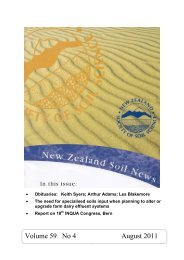Volume 55 No 2 April 2007 - New Zealand Society of Soil Science
Volume 55 No 2 April 2007 - New Zealand Society of Soil Science
Volume 55 No 2 April 2007 - New Zealand Society of Soil Science
You also want an ePaper? Increase the reach of your titles
YUMPU automatically turns print PDFs into web optimized ePapers that Google loves.
ook review<br />
Australian <strong>Soil</strong> Fertility Manual (Third Edition). Editor: Graham Price.<br />
Fertilizer Industry Federation <strong>of</strong> Australia and CSIRO Publishing, 2006.168pp.<br />
ISBN: 0-643-09021-5.<br />
Review by John Adams<br />
Since the first edition <strong>of</strong> the Australian <strong>Soil</strong> Fertility Manual was published in 1999, it has been a<br />
valuable guide, not just for the fertilizer industry but also for land-based primary producers <strong>of</strong> all types<br />
in Australia together with consultants and tertiary-level teachers <strong>of</strong> <strong>Soil</strong> <strong>Science</strong>.<br />
It is a real compendium <strong>of</strong> information, quite tightly packed into 168 pages <strong>of</strong> text and appendices. A<br />
large number <strong>of</strong> people have contributed to this manual but, because <strong>of</strong> good editing by Graham Price,<br />
the text has a very consistent style and is easy to read.<br />
The third edition has been revised to reflect an increased emphasis on the environmental fate <strong>of</strong><br />
nutrients and appropriate management strategies. This is based on the quite comprehensive<br />
information on soil physical, chemical and biological properties which forms the bulk <strong>of</strong> the chapter<br />
contents. Several chapters have been revised and rewritten from the earlier editions.<br />
<strong>New</strong> content covers liming practice and effectiveness, effects <strong>of</strong> fertilizers on food quality, long-term<br />
fertilizer use, decision support s<strong>of</strong>tware, budgeting for pr<strong>of</strong>itable nitrogen use and best management<br />
practices for nitrogen and phosphorus fertilizers. There is also a new chapter on regulations for<br />
handling and using fertilizers (in an Australian context).<br />
The appendices are a valuable resource too, providing detailed information including nutrient<br />
removals in a very wide range <strong>of</strong> crops and livestock, the composition <strong>of</strong> various fertilizers and soil<br />
amendments, physical properties <strong>of</strong> major fertilizer products and a broad discussion <strong>of</strong> the Australian<br />
soil orders. While this last appendix provides an approximate correlation between the Australian soil<br />
orders and other soil classification systems, <strong>New</strong> <strong>Zealand</strong> is not one <strong>of</strong> the others.<br />
The manual is an excellent source <strong>of</strong> information, and while some sections are obviously more<br />
relevant to Australian users, much <strong>of</strong> it is <strong>of</strong> universal value. This is particularly so for the very good<br />
basic information on the properties <strong>of</strong> soils and their interactions with water and added nutrients. It<br />
provides a very sound guide for primary producers and their fertilizer advisers or other consultants. It<br />
could also be a useful university text, although much <strong>of</strong> the basic content is broadly similar in<br />
coverage and level to that in McLaren and Cameron’s <strong>Soil</strong> <strong>Science</strong> text, which covers a wider content<br />
and is rather more relevant to <strong>New</strong> <strong>Zealand</strong> students. The Australian fertilizer industry is to be<br />
congratulated for continuing to support publication <strong>of</strong> the manual which undoubtedly will be widely<br />
used by many soil science practitioners.<br />
abstracts<br />
Comparison <strong>of</strong> the effectiveness <strong>of</strong> a nitrification inhibitor,<br />
dicyandiamide (DCD), in reducing nitrous oxide emissions in four<br />
different soils under different climatic and management conditions<br />
H. J. Di*, K. C. Cameron & R. R. Sherlock<br />
Centre for <strong>Soil</strong> and Environmental Quality, PO Box 84, Lincoln University, Canterbury, <strong>New</strong> <strong>Zealand</strong>.<br />
*Corresponding author: Fax: 0064 3 3253607; Email: dih@lincoln.ac.nz<br />
85










